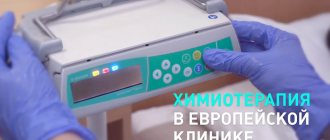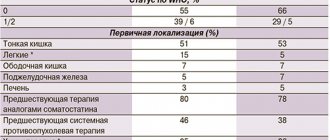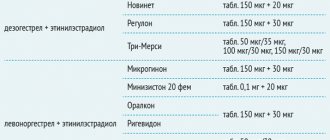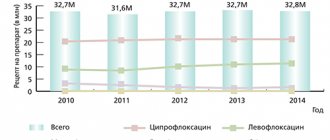Pharmacological properties of the drug Cisplatin
Antitumor agent, platinum compound. The mechanism of action is probably due to the binding of cisplatin to cell DNA with the formation of intra- and interhelical cross-links, which change the structure and suppress DNA synthesis. To a lesser extent, cisplatin inhibits protein and RNA synthesis. Cisplatin does not have phase specificity. After intravenous administration, the pharmacokinetic parameters of cisplatin are described by a two-phase pharmacokinetic model. The initial phase is rapid, with a half-life of 29–45 minutes, followed by a long phase with a half-life of 2–4 days. This duration of the elimination phase is likely due to the high degree of protein binding. Typically, more than 90% of cisplatin is bound to plasma proteins, but with slow IV administration this figure may be higher. It is excreted mainly in the urine. About 15–25% of the dose is excreted quickly, mainly as unchanged substance in the first 2–4 hours and 20–75% in the first 24 hours. The remaining amount binds to tissues and blood plasma proteins. Cisplatin appears to accumulate in the kidneys, liver, small intestine and testes. It does not penetrate the BBB and is not detected in the CSF in significant quantities. Its level in the CSF is low, although significant amounts can be detected in brain tumors.
Immunotherapy
Immunotherapy is a relatively new treatment for some types of lung cancer. Although any cancer treatment may cause side effects, immunotherapy is generally well tolerated; this is partly due to its mechanism of action.
The immune system is constantly working to keep us healthy. It recognizes and fights dangers such as infections, viruses and cancer cell growth. Immunotherapy uses a person's own immune system to treat cancer.
In March 2015, the FDA approved the immunotherapy nivolumab for the treatment of metastatic squamous cell NSCLC when previous treatment has failed. Nivolumab works by interfering with a molecular "brake" known as PD-1, which prevents tumors from being attacked by the body's immune system.
In 2016, the FDA approved the new immune drug pembrolizumab for the treatment of advanced NSCLC as first-line therapy. Its therapeutic activity is similar to that of nivolumab. Patients are tested for the presence of PDL-1 protein and, if it is detected in sufficient quantities, this is a criterion for prescribing these drugs.
Use of the drug Cisplatin
When used as monotherapy in children and adults, the doses and schedule of administration are as follows: 50–100 mg/m2 body surface as a single infusion over 6–8 hours every 3–4 weeks; IV or slow infusion of 15–20 mg/m2 daily for 5 days every 3–4 weeks. The dose should be reduced in patients with depressed bone marrow function. Repeated courses of cisplatin administration should not be started until:
- a) the level of creatinine in the blood serum will not decrease to 140 µmol/l; the level of urea in the blood plasma will not decrease to 9 mmol/l.
- b) the number of formed elements in the peripheral blood will not reach an acceptable level (platelets more than 100,000 per 1 mm3, leukocytes - more than 4000 per 1 mm3).
A basal audiogram should be performed and patients should be periodically assessed to determine hearing acuity. Patients should be adequately hydrated before and for 24 hours after cisplatin administration to ensure adequate diuresis and reduce nephrotoxicity. Hydration can be achieved by intravenous infusion of 2 liters of 5% glucose solution with the addition of 1/2–1/3 volume of 0.9% sodium chloride solution over 2–4 hours. The required amount of cisplatin for injection should be added to 1 liter of 0.9% sodium chloride solution and pour in for the required time. It is important to maintain adequate hydration and diuresis for 24 hours after cisplatin infusion. This can be achieved by administering 1–2 liters of 0.9% sodium chloride solution or a mixture of glucose and 0.9% sodium chloride solution for 6–12 hours. Cisplatin is usually used in combination therapy with the following cytotoxic drugs: in the treatment testicular cancer - vinblastine, bleomycin, actinomycin; in the treatment of ovarian cancer - cyclophosphamide, doxorubicin, hexamethylmelamine, fluorouracil; in the treatment of head and neck cancer - bleomycin and methotrexate. The dose is set in accordance with the chemotherapy regimen used.
What drugs are used for chemotherapy for lung cancer?
There are two main types of lung cancer: non-small cell (the most common, accounting for 80–85%) and small cell (10–15%). Approaches to their treatment vary. For non-small cell lung cancer, platinum drugs - cisplatin or carboplatin - are most often prescribed in combination with one of the following drugs: gemcitabine, vinorelbine, docetaxel (Taxotere), paclitaxel (Taxol), pemetrexed, etoposide.
Sometimes the regimen does not include platinum drugs; gemcitabine is used in combination with vinorelbine or paclitaxel. Usually a combination of two drugs is used. Studies have shown that adding a third drug does not significantly improve the result, but causes too many side effects. If the patient's health is so poor that he cannot tolerate two drugs, only one drug is prescribed.
If cancer cells have certain molecular genetic characteristics, targeted drugs are added to chemotherapy: bevacizumab (Avastin), ramucirumab (Cyramza) or necitumumab (Portrazza). Some patients are given immunotherapy.
Side effects of the drug Cisplatin
From the urinary system - cumulative, dose-dependent renal failure is the main toxicity factor limiting the dose of cisplatin. The most commonly observed decrease in glomerular filtration, manifested by an increase in serum creatinine levels. Adequate hydration before and after treatment may reduce the severity of nephrotoxicity. From the hematopoietic system , hematological toxicity is also dose-dependent and cumulative. The lowest platelet and white blood cell counts are usually observed between days 18 and 32 and return to baseline levels in most patients after 39 days. Leukopenia and thrombocytopenia are more pronounced when cisplatin is used in doses exceeding 50 mg/m2. Subsequent courses of cisplatin should not be started until the platelet count exceeds 100,000 per mm3 and the white blood cell count exceeds 4000 per mm3. A significant number of patients experience anemia (decrease in hemoglobin by more than 2 g%) - usually after several courses of treatment. In severe cases, red blood cell transfusion may be required. Cisplatin therapy can cause the development of hemolytic anemia with a positive Coombs test. Subsequent courses of cisplatin treatment may cause increased hemolysis in susceptible patients. On the part of the digestive system , nausea and vomiting develop in almost all patients receiving treatment with cisplatin; in some cases, they are so pronounced that there is a need to reduce the dose or discontinue treatment. There was an increase in the activity of AST and alkaline phosphatase with clinical signs of toxic effects on the liver. From the central nervous system and sensory organs - cumulative ototoxicity develops mainly when used in high doses. Commonly observed signs of ototoxicity are tinnitus or hearing loss. Tinnitus usually lasts from several hours to 1 week after stopping therapy. Hearing loss may be unilateral or bilateral in the range of 40,000–8000 Hz (in 10–30% of patients). The frequency and severity of such hearing damage increases with repeated courses and may be irreversible. Peripheral neuropathies include stocking-glove paresthesias, areflexia, and loss of vibration sensation, especially when cisplatin is given in high doses or more frequently than recommended. These neuropathies may be irreversible. Optic neuritis has been reported following the use of cisplatin. With long-term therapy, myasthenic syndrome and seizures may also occur (if such phenomena develop, cisplatin should be discontinued). Effect on Homeostasis: Hypomagnesemia and hypocalcemia may occur and manifest as muscle excitability or spasms, tremors, carpopedal spasms, and/or tetany. Hyperuricemia may develop, especially when using doses exceeding 50 mg/m2. Uric acid levels peak 3–5 days after cisplatin administration. Allergic reactions - anaphylactoid reactions, manifested mainly by facial swelling, dizziness, tachycardia, skin rashes and arterial hypotension. Reactions usually develop within a few minutes after administration of cisplatin; to eliminate them, epinephrine, corticosteroids and/or antihistamines are administered intravenously.
How is the patient prepared for treatment?
When preparing for chemotherapy for lung cancer, you need to take general and biochemical blood tests; in the future, they will have to be retaken before each cycle.
Currently, there are molecular genetic studies that help determine the optimal combination of drugs for each patient and prescribe personalized chemotherapy. Such tests are available for patients from Russia. They help improve the effectiveness of chemotherapy and select appropriate treatment if chemotherapy drugs stop working.
Special instructions for the use of Cisplatin
Treatment with cisplatin should only be administered by a physician experienced in chemotherapy. To reduce the risk of nephrotoxicity, patients should be hydrated before, during and after therapy. Before starting treatment, and then before administering subsequent doses, it is necessary to monitor the following parameters: renal function, including the level of glomerular filtration, urea nitrogen, creatinine in the blood; water and electrolyte balance to detect hypermagnesemia and hypercalcemia; hearing function; number of red blood cells, white blood cells and platelets; liver function and neurological status. The drug should be prescribed with caution to patients with impaired liver and kidney function. Patients receiving cisplatin should be monitored for early detection of possible anaphylactoid reactions; To treat these types of reactions, medications and necessary equipment must always be available. The risk of developing anaphylactoid reactions is increased in patients with a hereditary predisposition to allergic diseases. Children are more likely to develop ototoxicity than adults. Cisplatin has a mutagenic, teratogenic and embryotoxic effect. Cisplatin should be prescribed to women of reproductive age only in cases where the expected therapeutic effect outweighs the risk of such therapy, and patients in this case should use reliable contraception. If pregnancy occurs while using cisplatin, the patient should be informed of the possible harmful effects on the fetus.
results
During therapy, the patient undergoes diagnostics at certain intervals so that doctors evaluate the tumor’s response to treatment and predict further actions. For this purpose, radiation examination methods are used.
- A complete tumor response is recorded if the tumor has completely disappeared.
- Partial response - if the tumor has decreased by half or more, and there are no signs of progression.
- Stabilization - the neoplasm stabilizes in a certain state, without decreasing or progressing.
- Progression - the tumor does not respond to therapy and grows, or a new focus of the disease appears.
The specialists of the oncology center will do everything possible to improve the patient’s condition at any stage of the disease, achieve a complete response and sustainable remission.
Is it possible to endure a course of chemotherapy comfortably?
Chemotherapy drugs can damage not only tumor cells, but also healthy cells, causing side effects. The latter depend on the type and dose of the drug, the individual reaction of the patient.
The most common effects of chemotherapy for lung cancer: fatigue, fatigue, loss of appetite, weight loss, increased bleeding, decreased immunity and increased risk of infections, hair loss, diarrhea, constipation.
In order to reduce the risk of side effects, it is important to correctly assess the patient’s condition, select the dosage and regimen of drug administration. There is maintenance therapy that helps to cope with symptoms and endure the course of chemotherapy comfortably.
Most side effects are temporary and disappear soon after treatment is completed. But some can persist for a long time.
It’s worth talking to your doctor before starting treatment, asking what side effects may occur in your case, how to prevent them, how to deal with them, and what symptoms require immediate medical attention.






